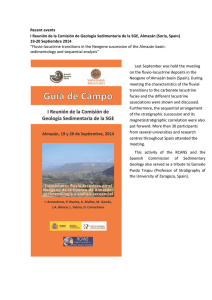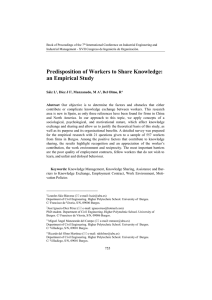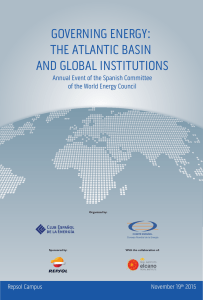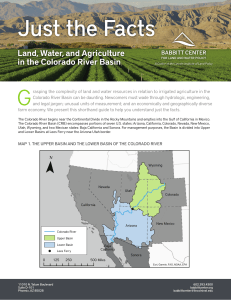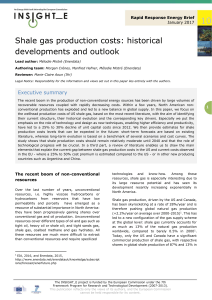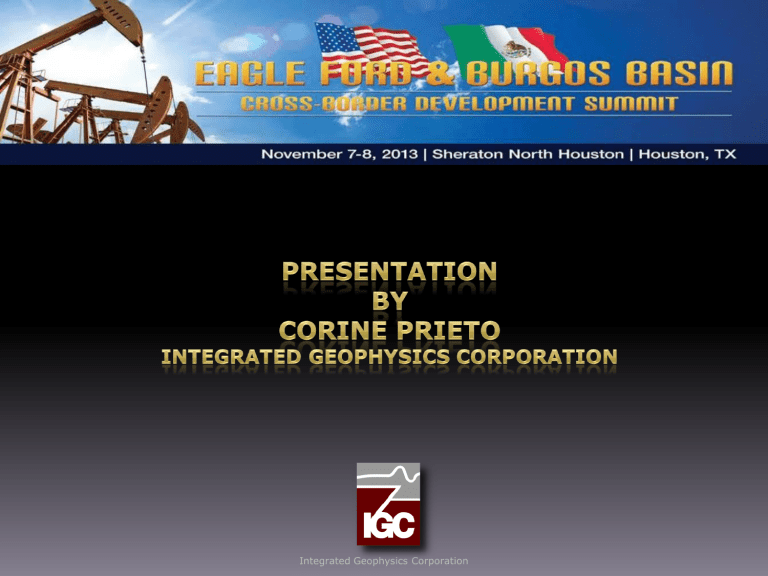
Integrated Geophysics Corporation Structural Framework Burgos Basin Integrated Geophysics Corporation ASSESSING THE POTENTIAL OF THE BURGOS BASIN Structural framework of the Super Burgos Basin Correlation to production trends: Tertiary Plays: Frio, Vicksburg & Wilcox Cretaceous Play: Eagle Ford (Agua Nuevo & San Felipe) Jurassic Play: La Casita (Pimienta) Distinctions between South Texas Basin & Mexican Burgos Basin Current Shale Wells Basement structure & depths Why structure is important in the Burgos Basin Integrated Geophysics Corporation Reduced-to-Pole Magnetic Intensity Northeastern Mexico Coahuila State Data Map Source: World Digital Magnetic Anomaly (WDMAM) grid file Sept 2007 Onshore area: 24,200sq mi. South Texas Basin Grid: 1 kilometer data grid Southern extension of the Maverick Basin Texas Western extension of the South Texas Basin Range: -186 to 413nT RTP: IGC calculation Unfortunately, the regional data control of the World Map data allows only for a qualitative analysis. Integrated Geophysics Corporation Reduced-to-Pole Magnetic Intensity This aeromagnetic map was selected to illustrate complex relationship of the sub-basins bounded by significant structural elements: •mega-shears, •basement structures •surface geology Super Burgos : name coined for the area bounded by the megashears. Integrated Geophysics Corporation Sub- Basins Mexico’s Shale Sub Basins -appears to be of good quality. - a complex of related sub-basins bounded by the significant structural elements. - geologic structure of the sedimentary basins are considerably more complex. South Texas Basin -South Texas & Burgos are outlined as the one sub-basin within the Super Burgos area. - compared to US Coastal gently dipping shale belts, Mexico’s coastal shale zone is narrower, less continuous and structurally more disrupted. -All other sub-basins outlined lie within Burgos Basin; all are correlate to Border Rift System. Reduced-to-Pole Magnetic Intensity Integrated Geophysics Corporation Frio, Vicksburg and Wilcox Trends Frio 1948 -Reynosa Vicksburg 1945 - Mision Wilcox 1959 -Penalva East-Central Mexico Stratigraphy Integrated Geophysics Corporation Frio, Vicksburg and Wilcox Trends Production Conventional exploration started 1911 Tertiary Plays generally described as South Texas Basin growth fault related plays. Tertiary sequence rocks have a regional dip toward the east and are affected by a serious of major normal faults roughly parallel to the coastline and with displacement downward to the Gulf Coast. Today - 3,500 active natural gas wells Source: 80% from Upper Jurassic (Tithonian) & Paleogene Shales Reduced-to-Pole Magnetic Intensity Integrated Geophysics Corporation Miocene & Tertiary Growth Fault Plays Conventional Sandstone Reservoirs 20 distinct plays E B Source: Echanove, 1986 Growth faults are the dominant trap which includes anticlines, tilted blocks, and sedimentary wedges on the downside of the fault. Source: Hernandez-Mendoza, 2008 Integrated Geophysics Corporation Agua Nuevo (Eagle Ford) and La Casita (Haynesville) Trends As of Sept 2013: 343 Tcf gas & 6.3bb projected Eagle Ford Agua Nuevo (San Felipe) Late 2010- 6 shale wells Haynesville La Casita (Pimienta) March 2013 PEMEX Anhelido-1 – 400b/d of shale liquids East-Central Mexico Stratigraphy Integrated Geophysics Corporation Aqua Nuevo –San Felipe Shale plays - Cretaceous and Upper Jurassic sequence contains basinal, organic-rich and thermally mature argillaceous rocks. This includes the Aqua Nuevo and La Casita including the Pimienta. Anheldo-1 1st shale oil well discovery: La Casita formation (dry gas) March 2013 Reduced-to-Pole Magnetic Intensity Integrated Geophysics Corporation Production Summary As of Sept 2013 Modest gas flows (>3 million cft/day) Wells exhibit steep declines Well cost: $20-25 million per well PEMEX plans to drill 75 Burgos shale wells thru 2015 & increase production to 2B cft/day by 2025 To-date 7 shale related wells have been drilled: Emergente dry gas 4,071m 13,358ft Percutor-1 dry gas 3,436m 11,270ft Habano-1 gas/con 3,770m 12,366ft Montanes-1 gas/con 3,200m 10,496ft Nomada-1 --- 2,850m 9,348ft 4,007m 13,143ft Arbolero-1 dry gas Anhelido-1 oil & gas 3,945m 12,940ft Reduced-to-Pole Magnetic Intensity Integrated Geophysics Corporation Regional Cross-Section of Wells across the Six Basins Note: the influence of the basement structure to the success of deep Jurassic play: La Casita & Pimienta. Integrated Geophysics Corporation Fault Composite & Regional RTP Megashear (Jurassic) Megashears & Transforms have influence the generation of the depocenters for oil & gas generation (sub-basins) & therefore the prospective area for shale exploration. Discontinuities parallel to the direction of Atlantic opening. Transforms (Cretaceous) Northern Burgos Basin is related to the South Texas Basin. These features are recognized by: - linear block boundaries - block offsets - fold offsets - stratgraphic changes. Southern Burgos Basin is best described as the Border Rift System. Integrated Geophysics Corporation Chittim Arch located in the Maverick Basin US illustrates the structural complexity of the reservoir sands Jurassic Chittim Anticline is an interesting feature. Located in center Maverick county – runs NW-SE for 30 miles (18km) & is 2 miles (1.2km) wide Source: Ewing 2012 Good example of possible systems that underlie other folds in the Burgos Basin. The surface structure reflects the fold cover over a deep half-graben complex Similar structures can be identified with regional gravity & magnetic data. Integrated Geophysics Corporation Barrel of Oil Equivalent is high: 343 Tcf & 6.3bb gas & oil projected by ARI June 2013. Burgos Basin & South Texas Basin are related as bounded by Jurassic mega tectonic shears Basins have the same Miocene & Tertiary structures – regional normal faults roughly parallel to the coastline and with displacement downward to the Gulf Coast. Basins differ in their deep structural configurations. Structural framework of Burgos is complicated by close-spaced Cretaceous transfer systems. Aqua Nuevo (San Felipe) will be impacted by these K transfer faults; unlike the US Eagle Ford. Jurassic Play: La Casita (Pimienta) will be governed by rift geometries. Cross-trend structures, rift valleys, tilted blocks Exploration strategy will have to be cost efficient & include state-of-theart technology and multiple data sources Integrated Geophysics Corporation Advanced Resources International, Inc. for U.S. Energy Information Administration & U.S. Department of Energy, Technically Recoverable Shale Gas and Shale Oil Resources: An Assessment of 137 Shale Formations in 41 Countries Outside the United States, EIA/ARI World Shale Gas and Shale Oil Resource Assessment, Mexico, section II p. 1-26, June 2013 Beebe B.W., Occurrence of Natural Gas in Mexico, AAPG Memoir M 9: Natural Gases of North America, Volume One, p. 209-232, 1968 Dixon B., Flint D., ¡MEXICO! A New Opportunity, CIM Petroleum Society. Petroleum Economics Special Interest Group. March 27, 2003 Ewing T. E., Tectonic domains in the Rio Grande / Rio Bravo border region, Texas and Mexico: Laramide structures suggest earlier history: Gulf Coast Association of Geological Societies Transactions, v. 61, p. 141–155. Fredrick J., Mexico boasts first shale oil, BNamericas, http://www.bnamericas.com/news/oilandgas/mexico-boasts-first-shale-oil, March 7, 2013 Galicia-Barrios, Guadalupe J., Mexico’s Shale Oil and Gas Plays: Potential and Exploration Strategy,; AAPG Search and Discovery Article #90166©2013 AAPG International Conference & Exhibition, Cartagena, Colombia, 8-11 September 2013 Hackley, P.C., Geological and geochemical characterization of the Lower Cretaceous Pearsall Formation, Maverick Basin, south Texas: A future shale gas resource?,AAPG Bulletin, V. 96, No. 8 (August 2012), P. 1449–1482 Hentz T. F., Ruppel S. C., Regional Stratigraphic and Rock Characteristics of Eagle Ford Shale in Its Play Area: Maverick Basin to East Texas Basin, Search and Discovery Article #10325 (2011) Hernandez-Mendoza J. J., Hentz T. F., DeAngelo M. V., Wawrzyniec T. F., Sakurai S., Talukdar S. C., and Holtz M. H., Miocene chronostratigraphy, paleogeography, and play framework of the Burgos Basin, southern Gulf of Mexico, AAPG Bulletin, V. 92, No. 11 (November 2008), P. 1501-1535 Lozano, Roberto, The challenges for shale gas production in Mexico, Regional Workshop on the Changing Global Market and Unconventional Gas, 6-8 May 2013, Jakarta, nesia Prieto C., Rowe J. D., A new frontier: Deep gas exploration offshore South Texas, USA—An assessment tool, Gulf Coast Association of Geological Societies Transactions, v. 57, p. 663-666. Yurewicz D. A., Chuchla R. J., Richardson M., Pottorf R. J., Gray G. G., Kozar M. G., Fitchen W. M., Hydrocarbon generation and migration in the tampico-Misantla basin and Sierra Madre Oriental, East-Central Mexico: evidence from an exhumed oil field in the Sierra De El Abra, Sedimentation and Diagenesis of Middle Cretaceous Platform Margins, East-Central Mexico, 1997, p. 1-24 Integrated Geophysics Corporation www.igcworld.com


![Presentacion Chile - Canada [Modo de compatibilidad]](http://s2.studylib.es/store/data/006031439_1-d894d5d2d359230b5c2007cc916df922-300x300.png)
